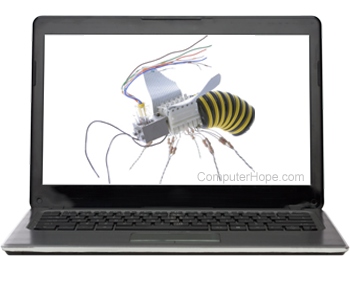How to remove a virus and malware from my computer

Viruses and malware can cause many problems on a computer. If you suspect your computer has a virus or malware infection, review the sections below for help and suggestions on quarantining or eliminating the infection.
If you're concerned about a specific file being a virus, see: Is this file infected with spyware, virus, or other malware?
Virus detection and removal
If your computer or storage device, like a USB (Universal Serial Bus) flash drive, is infected with a virus or malware, run an antivirus scan on the computer. Open your antivirus scanner through the Windows notification area or Start menu and run a full system scan to check all files on your computer for a virus.
By default, antivirus programs usually scan the primary hard drive on a computer and not other storage drives, like USB flash drives. Access the settings in your antivirus program and make sure it is set to scan all drives connected to the computer.
If you're unable to boot to Windows, boot the computer to Safe Mode and run the scan from Safe Mode.
Removing detected virus
If the antivirus program detects the virus, a prompt to move the virus to the virus vault or delete the infected files are given. Both options are a good way to remove the virus from the computer.
I don't have an antivirus program installed
If you are running Windows 8, Windows 10, or Windows 11 on the computer, you may be using Windows Defender as your antivirus.
Try running an online virus scan if you do not have an antivirus or Windows Defender but still believe a file is infected with a virus. These websites scan your computer hard drive for any infections.
We don't recommend manually finding and deleting files on your computer if you suspect you have a virus. Deleting the wrong files could result in errors on your computer or cause the operating system to become unusable.
No virus is detected
Unfortunately, many non-virus-related issues are often blamed on computer viruses. Nine times out of ten, a computer problem is a software, driver, or hardware-related issue and not a virus. If no viruses are found after running the antivirus scan, it's very likely the computer is not infected. If you still believe your computer is somehow infected, you may also consider running an online virus scan and scanning the computer with a malware protection program, as mentioned below.
Malware, spyware, and adware detection and removal
Some antivirus programs, like Webroot SecureAnywhere, include malware protection in addition to virus protection. If your antivirus program does not include malware protection, we strongly recommend running a malware protection program, such as Malwarebytes. Malware can cause computer errors and other problems.
How to scan the computer or get software if the Internet is not working
If your Internet is not working, follow the steps below to get a protection program on your computer.
- Download antivirus software, such as Malwarebytes, to another computer. Then, transfer it to a USB thumb drive, and use the thumb drive to run Malwarebytes on the infected computer.
- Copy the download to a USB flash drive.
- Install the program from the flash drive on your computer.
